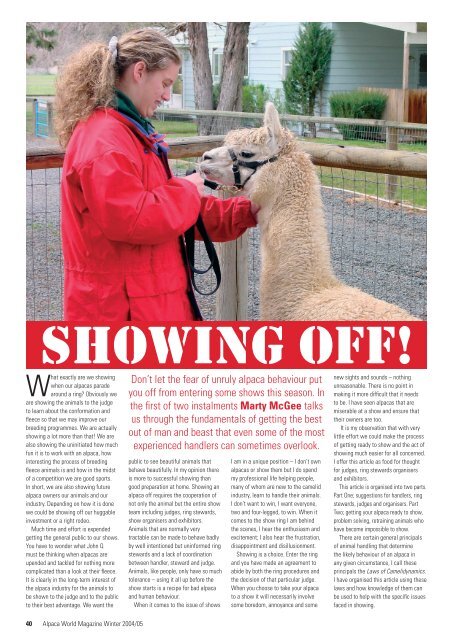You also want an ePaper? Increase the reach of your titles
YUMPU automatically turns print PDFs into web optimized ePapers that Google loves.
What exactly are we showing<br />
when our alpacas parade<br />
around a ring? Obviously we<br />
are showing the animals to the judge<br />
to learn about the conformation and<br />
fl eece so that we may improve our<br />
breeding programmes. We are actually<br />
showing a lot more than that! We are<br />
also showing the uninitiated how much<br />
fun it is to work with an alpaca, how<br />
interesting the process of breeding<br />
fl eece animals is and how in the midst<br />
of a competition we are good sports.<br />
In short, we are also showing future<br />
alpaca owners our animals and our<br />
industry. Depending on how it is done<br />
we could be showing off our huggable<br />
investment or a right rodeo.<br />
Much time and effort is expended<br />
getting the general public to our shows.<br />
You have to wonder what John Q<br />
must be thinking when alpacas are<br />
upended and tackled for nothing more<br />
complicated than a look at their fl eece.<br />
It is clearly in the long-term interest of<br />
the alpaca industry for the animals to<br />
be shown to the judge and to the public<br />
to their best advantage. We want the<br />
40 Alpaca World Magazine <strong>Winter</strong> 2004/05<br />
Don’t let the fear of unruly alpaca behaviour put<br />
you off from entering some shows this season. In<br />
the fi rst of two instalments Marty McGee talks<br />
us through the fundamentals of getting the best<br />
out of man and beast that even some of the most<br />
experienced handlers can sometimes overlook.<br />
public to see beautiful animals that<br />
behave beautifully. In my opinion there<br />
is more to successful showing than<br />
good preparation at home. Showing an<br />
alpaca off requires the cooperation of<br />
not only the animal but the entire show<br />
team including judges, ring stewards,<br />
show organisers and exhibitors.<br />
Animals that are normally very<br />
tractable can be made to behave badly<br />
by well intentioned but uninformed ring<br />
stewards and a lack of coordination<br />
between handler, steward and judge.<br />
Animals, like people, only have so much<br />
tolerance – using it all up before the<br />
show starts is a recipe for bad alpaca<br />
and human behaviour.<br />
When it comes to the issue of shows<br />
I am in a unique position – I don’t own<br />
alpacas or show them but I do spend<br />
my professional life helping people,<br />
many of whom are new to the camelid<br />
industry, learn to handle their animals.<br />
I don’t want to win, I want everyone,<br />
two and four-legged, to win. When it<br />
comes to the show ring I am behind<br />
the scenes, I hear the enthusiasm and<br />
excitement; I also hear the frustration,<br />
disappointment and disillusionment.<br />
Showing is a choice. Enter the ring<br />
and you have made an agreement to<br />
abide by both the ring procedures and<br />
the decision of that particular judge.<br />
When you choose to take your alpaca<br />
to a show it will necessarily involve<br />
some boredom, annoyance and some<br />
new sights and sounds – nothing<br />
unreasonable. There is no point in<br />
making it more diffi cult that it needs<br />
to be. I have seen alpacas that are<br />
miserable at a show and ensure that<br />
their owners are too.<br />
It is my observation that with very<br />
little effort we could make the process<br />
of getting ready to show and the act of<br />
showing much easier for all concerned.<br />
I offer this article as food for thought<br />
for judges, ring stewards organisers<br />
and exhibitors.<br />
This article is organised into two parts.<br />
Part One; suggestions for handlers, ring<br />
stewards, judges and organisers. Part<br />
Two; getting your alpaca ready to show,<br />
problem solving, retraining animals who<br />
have become impossible to show.<br />
There are certain general principals<br />
of animal handling that determine<br />
the likely behaviour of an alpaca in<br />
any given circumstance, I call these<br />
principals the Laws of Camelidynamics.<br />
I have organised this article using these<br />
laws and how knowledge of them can<br />
be used to help with the specifi c issues<br />
faced in showing.







